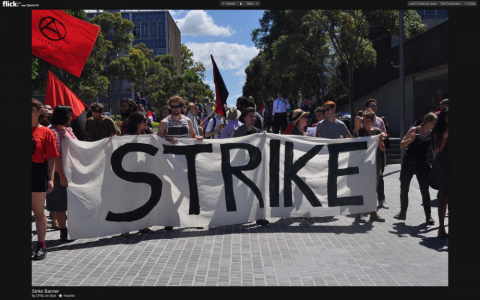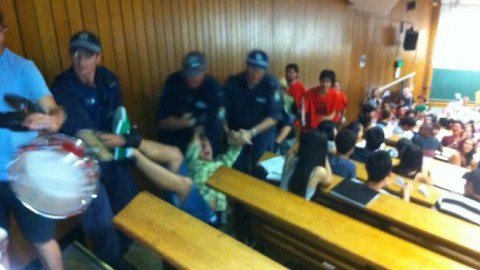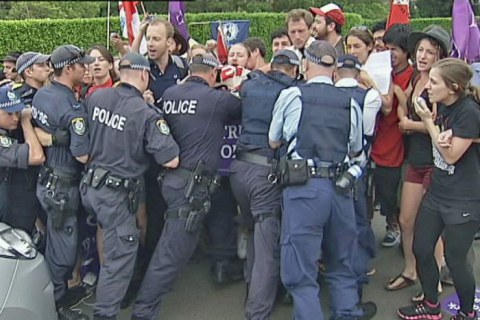Tuesday March 26 marked the begining of a 48 hour strike at Sydney university. The strike was called by the NTEU with CPSU support as a continuation of the struggle against the uni administrations new Enterprise Bargaining Agreement, intended to undercut staff conditions, increase casualisation, micromanagement and surveillance under the familiar guise of "flexibility". In the early hours of March 26, some anarchists once again broke into the City rd Catholic college (or chapel of the Insurrection) and again dropped a massive banner reading
“WE ARE THE UNI WE CAN SHUT IT DOWN
STAFF + STUDENTS STRIKE”
At 6.45am we joined hundreds of staff, students and socialists in picketing and barricading seven different entrances to the uni.
Early in the morning a contingent of riot police attempted to break a picket at the city rd car park entrance. After a brief scuffle in which the picketers managed to hold their ground, the riot pigs retreated in humiliation.
Meanwhile the parramatta rd footbridge was barricaded by anti-authoritarians who soon came into conflict with NTEU officials who collaborated with police to break the picket to allow scabs and students to pass. Militant picketers were told by NTEU bureaucrats that they had to lets scabs pass or “the union could be fined for illegal activity”
From 9am on, some crews of anarchists roamed the uni in a series of roving noise pickets, passing out hundreds of anti-cop and anti-scab leaflets, writing messages on uni walls and disrupting lectures, libraries and businesses. Any commercial operation within the uni territory was fair game. We banged pots, drums, shouted at scabs and chanted against classes, cops and capital. Anyone on campus studying, working in an office, coffee shop or lecturing was acting as a strike breaker and we made sure to inform them what this meant. We aimed to disrupt any semblance of normality on the uni grounds, to assert our right to this territory against the claims of capitalists like Michael Spence and his riot pigs.
Some members of the socialist sects (who noticed the effectiveness of the roaving pickets) then marched a large contingent of students into a chemistry lecture, though rather then shouting insults at the scab and passing leaflets to students then leaving, they decided to occupy the hall and make long speeches to the chemistry students. The police soon mobilised the riot squad which burst into the lecture hall, violently dragging out picketers and arresting two of them. A crowd of angry students and anti-authoritarians then confronted police chanting “COPS OFF CAMPUS” and “NO JUSTICE, NO PEACE, FUCK THE POLICE!” Police responded by violently pushing and dragging the crowd out the building.
The riot pigs specifically targeted students of colour and those who were filming them and made 3 more arrests outside before dragged them into another building, where a crowd assembled to demanded the release of the hostages. Some trotskyite leaders then used their megaphone to order those acting in solidarity to leave the police alone and return to the picket. Instead many of the most militant picketers left the uni to make a noise demo outside Newtown cop shop. Though two arrestees were later released without charge, three more now face trumped up charges ranging from assault to hinder police.
On the following day pickets were established before 7am. Militant picketers soon marched from the Paramatta rd bridge to the City rd car park entrance and blocked cars for a number of hours before the riot squad began aggressively forcing picketers back whenever a scab wanted to drive through. After a number of minor scuffles the cops made the choice to block entrance with their car, to ease hostilities. Many picketers then broke away to cause disruptions in the operation of the library and coffee shops.
One student strike supporter complained that we were acting like “psychopaths” and asked, “what image do you want to project?”. We respond that the only things we wish to project are bricks at the pigs that arrest us and our loved ones, bricks we will then use to build the communal free schools of the future. We couldn't give a fuck about the pathetic attempts by some students to act out the prescribed role of 'good protesters' for the corporate media. We do not perform for the media, we wish to sow class tension and spread the practice of sabotage amongst staff and students. As neoliberal restructuring deepens and the divide between the owners and managers of capital and those excluded from profits an production increases, this tension will inevitably rupture into open conflict. We wish to bring on the violent storms of class warfare, as the rebellious Greek youth sprayed across walls during the December 2008 insurrection, “we are an image from the future.”
At 12pm, a student rally had bee called by the National Union of Students (NUS) at UTS just a couple kilometers down George street. The rally was just one manifestation amongst many of the National Day of Action against for-profit education. While the NUS announced the rally would march from the UTS campus to Town Hall, a large contingent of strikers marched to UTS and convinced the students to change their route and instead march to Sydney Uni in solidarity with the strike.
As the initial contingent left Sydney uni, riot police launched an unexpected assault on a largely anti-authoritarian picket, taking another two hostages who'd been captured the previous day.
Over a thousand students from the NUS rally marched down George street onto City rd, before initiating a spontaneous sit in on one of Sydney's busiest arteries. Police immediately freaked out but where unable to respond because of the massive number of students involved. As usual, members of trotskyist sects, alarmed by an action they had not promoted and were not directing, began using their megaphones to implore the crowd to leave the road. When this was at first unsuccessful, they resorted to a familiar tactic of theirs and called for a vote on whether people wanted to hold the street. As always these Leninist are only capable of draining energy and initiative from any moment of actual class conflict. While anarchists and anarcho-syndicalists continued to push for generalised disruptions across campus, the Trotskyite politicians successfully managed to disperse the large angry crowd of students with their repetitive and boring speeches that no one ever wants to hear.
With riot police encircling the dwindling crowd, clearly waiting for a small group to cause any disruption that could be used as a pretext for arrests, most militant activists decided to leave the uni to make another noise demo outside the cop shop in solidarity with the arrestees.
Police denied both comrades bail and vindictively delayed their processing till after courts closed and held them overnight. The following day over 20 people showed up at the court in solidarity and welcomed the comrades back to relative freedom on their release.
The neoliberal restructuring of the economy toward the privatisation, casualisation and generalised precarity of employment (in the interest of a narrow class of professionals) can only be enforced with batons, tasers and prison cells. The militarisation of police and the privatisation of our lives are merely two sides of a process of exclusion and exploitation. As students and workers we are hit first by higher fees, debt, casualisation and layoffs, then by police violence if we take a stand.
To take control of our destinies we cannot rely on those individuals and organisations who position themselves as our representatives. While we are willing to work with unions and student associations when it is necessary, we do not recognise their authority. We must act on our own behalf directly, without the mediation of organisers or spokespeople. We must break with any groups that seek to limit the struggle by telling us to leave the street, go back to work or class, to negotiate, to reconcile.
As an alternative to being herded by representatives, we call on students and workers to organise themselves collectively outside the structures of political parties or unions. We urge undergraduates, lecturers, service workers and staff to begin meeting together to discuss their situation. The more we begin talking to one another and finding our common interests, the more difficult it becomes for the administration and police to pit us against each other. To intensify our resistance, our immediate task is to create spaces of solidarity, care and freedom, where we can find one another to conspire against the conditions imposed on us by capital.
Occupations can liberate common spaces, negate existing property relations and assert the collective desire for that which is shared. We must physically expel the police and the administration from the territory of Usyd in order to create a free, open and communal university of resistance.
TOWARD THE SYDNEY UNI COMMUNE



